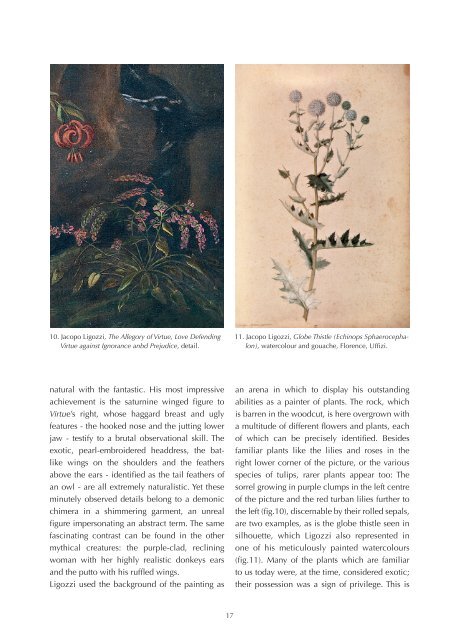You also want an ePaper? Increase the reach of your titles
YUMPU automatically turns print PDFs into web optimized ePapers that Google loves.
10. <strong>Jacopo</strong> <strong>Ligozzi</strong>, The Allegory of Virtue, Love Defending<br />
Virtue against Ignorance anbd Prejudice, detail.<br />
11. <strong>Jacopo</strong> <strong>Ligozzi</strong>, Globe Thistle (Echinops Sphaerocephalon),<br />
watercolour and gouache, Florence, Uffizi.<br />
natural with the fantastic. His most impressive<br />
achievement is the saturnine winged figure to<br />
Virtue’s right, whose haggard breast and ugly<br />
features - the hooked nose and the jutting lower<br />
jaw - testify to a brutal observational skill. The<br />
exotic, pearl-embroidered headdress, the batlike<br />
wings on the shoulders and the feathers<br />
above the ears - identified as the tail feathers of<br />
an owl - are all extremely naturalistic. Yet these<br />
minutely observed details belong to a demonic<br />
chimera in a shimmering garment, an unreal<br />
figure impersonating an abstract term. The same<br />
fascinating contrast can be found in the other<br />
mythical creatures: the purple-clad, reclining<br />
woman with her highly realistic donkeys ears<br />
and the putto with his ruffled wings.<br />
<strong>Ligozzi</strong> used the background of the painting as<br />
an arena in which to display his outstanding<br />
abilities as a painter of plants. The rock, which<br />
is barren in the woodcut, is here overgrown with<br />
a multitude of different flowers and plants, each<br />
of which can be precisely identified. Besides<br />
familiar plants like the lilies and roses in the<br />
right lower corner of the picture, or the various<br />
species of tulips, rarer plants appear too: The<br />
sorrel growing in purple clumps in the left centre<br />
of the picture and the red turban lilies further to<br />
the left (fig.10), discernable by their rolled sepals,<br />
are two examples, as is the globe thistle seen in<br />
silhouette, which <strong>Ligozzi</strong> also represented in<br />
one of his meticulously painted watercolours<br />
(fig.11). Many of the plants which are familiar<br />
to us today were, at the time, considered exotic;<br />
their possession was a sign of privilege. This is<br />
17
















